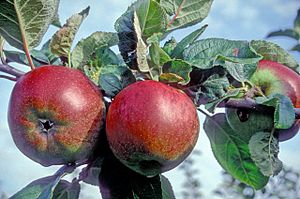Norfolk Biffin facts for kids
Quick facts for kids 'Norfolk Biffin' |
|
|---|---|
 |
|
| Cultivar | 'Norfolk Biffin' ('Norfolk Beefing') |
| Origin | Norfolk, England. Before 1807 |
The Norfolk Biffin is a special type of apple. It's also called Norfolk Beefing. This apple first came from Norfolk, a county in England. You might also hear it called by other names like Reeds Baker or Winter Coleman.
The name "Biffin" probably comes from "beefing." This is because the apple has a dark red color, a bit like beef! Or maybe "beefing" came from "biffin."
What Makes the Norfolk Biffin Special?
Norfolk Biffin apples are round, but a little bit flat. They are about seven centimeters (three inches) wide and six centimeters (two and a half inches) tall. Their skin is yellow-green with streaks of brown-purple and dark red.
Inside, the apple flesh has a green tint. It's crisp and some people say it tastes a little like cinnamon. These apples are great because they store well for a long time. They even get sweeter the longer you keep them!
They are perfect for cooking and drying. If you keep them until March of the next year, they become sweet enough to eat fresh as a dessert apple. As they get older, their color turns a deeper brown or maroon. Their flesh also becomes harder and more solid.
In the past, these apples were very popular with bakers in Norwich. They were even sent to fruit sellers in London as a special treat. People also used them to make cider.
The apple trees grow strongly and produce lots of fruit. Sometimes, if there are too many apples, some need to be removed so the others can grow bigger.
How to Make "Biffins" (Dried Apples)
When Norfolk Biffin apples are dried slowly in an oven, they are called "biffins." These dried apples look flat and feel soft. They were made in large amounts in Norfolk, England.
To make them, the apples are baked very slowly for a long time. In the past, children loved biffins as a treat, just like kids today might enjoy ice cream or chips. People would also take them home to eat with cream.
First, the whole apples were cooked slowly. Then, their cores were removed, and they were rubbed with sugar. To eat them, you would peel off the tough skin. Then, you could add more sugar and cream. People usually ate them cold or at room temperature. Biffins were very popular in Victorian times but became less common after World War II.
The History of the Norfolk Biffin
The Norfolk Biffin apple has been grown for over 300 years! It was often used for drying to make those special "biffins." A "biffin" was a baked apple flattened like a small cake.
Records from 1698 show that Robert Walpole enjoyed these apples. He later became the first Prime Minister of Great Britain. He had Norfolk Biffin apples sent to his house in London. This apple was also known in the United States by the 1840s.
The famous writer Charles Dickens mentioned the Norfolk Biffin in several of his books. In A Christmas Carol, he described them as "squab and swarthy" (meaning short, fat, and dark). He said they looked so juicy that they made you want to buy them and eat them after dinner. In another story, Boots at the Holly-tree Inn, a character asks for a "Norfolk biffin" to cheer someone up.
A food writer named Eliza Acton also praised the Norfolk Biffin in her cookbook from 1845. She said it was the best apple to use for a dish called 'Black Caps par Excellence', which was a baked apple with wine and lemon peel.
An old recipe from 1882 explains how to make biffins. It says to choose perfect Norfolk Biffins. Then, lay them on straw in a very slow oven for four to five hours. After that, you gently press them flat. Then, you put them back in the oven for another hour and press them again. Once they are cold, you rub them with sugar.
In Victorian London, biffins were a popular Christmas treat. Bakers in Norwich would cook them in their bread ovens. They would place an iron plate on top of the apples to press them flat and keep air out.
Today, you don't see the Norfolk Biffin apple in many English orchards. Other types, like the Cox's Orange Pippin, became more popular. However, some gardeners still grow them at home, and you can still buy them from some places.


